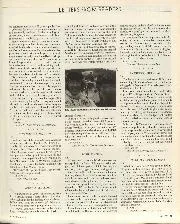
Aston Martin at Le Mans
Sir, What have you done? You have ended my 20-year search for a film of the 1959 Le Mans victory which David Brown so deserved. I have collected every scrap…
Sir,
I should like to congratulate S/Ldr.
Marris on his article on suspension in the April issue, but there is one statement he makes that I would like to correct. He says that ” When a rapidly rotating wheel is tilted, gyroscopic action introduces a force which tends to oppose tilting.” This is not quite true. When a rotating wheel is tilted, so as to rotate about a fore-and-aft axis, a torque is produced about an axis mutually at right angles to both this axis and the axis about which the wheel is spinning, that is to say, about the axis of the king-pin. This torque will, of course, tend to affect the steering, but if it is completely resisted, then there will be no torque tending to resist the tilt about the fore-and-aft axis. If, however, the wheel is allowed to turn about the steering axis, due to reversibility of the steering gear, or spring in the steering linkage, there will be a torque produced tending to oppose the tilt of the -wheel in bump. If irreversible steering and a well-designed linkage system is used, this effect becomes
negligible. I have never seen any figures for the
magnitude of the torque tending to upset the steering for swinging axles in bump, so I thought I would work out an example. The general formula for gyroscopic torque is T = Lon , where I is the moment of inertia of the wheel and tyre about its axle, c• is the angular velocity of the wheel spinning about its axle, and n is the angular velocity about the axis of pre
cession. If the speed of the car is V ft./sec. and the rolling radius of the wheel is 15 in., then the angular velocity about the axle will be ‘V12radians/sec. 15 If the radius of gyration of the wheel and tyre is 10 in., and the weight 40 lb., then 1=40 x (12=27.8 lb. ft.2. 12 If the wheel meets a bump, causing it to rise H inch in one foot travel, then the vertical velocity of the wheel will be HV
—12 ft./sec., assuming it to be uniform. If the length of the swinging axle, from the wheel to the pivot, is 2 ft. then the angular velocity of the wheel will be HV rad./sec. (Provided that H is 12 x 2 small compared with 2 ft.) Therefore the torque on the steering is
27.8 x 12 V x HV=0.927 HV2 poundals ft. 16 24 To bring this to lb. ft., we divide by g=82 (approx.)
Therefore the torque =0.029HV2 lb. ft. (Incidentally, S/Ldr. Marris’s torques should be expressed in lb. in. rather than in lb./in.) [This was a typographical error.—En.] Now, if H=2 in., and V=44 ft./sec.= 80 m.p.h., the torque will be 0.029 x 2 x
.
442=112 lb. ft., thus it can be seen that the torque, even at this speed, is by no means negligible, but if the speed is raised to 90 m.p.h., the torque will become 1,000 lb. ft. approx. This means that if the steering arm is 9 in. long, there will be a force applied to the end of the track rod of about 150 lb. at 80 m.p.h., and about 1,300 lb., or over half-a-ton, at 90 m.p.h. Now let us assume that we have irreversible steering, but that there is some spring in the steering linkage, so that a torque of 100 lb. ft. on the wheel causes an angular movement of 0.005 radian, which is reasonable. That is to say, the angular rate of the wheel in the steering plane is 20,000 lb. ft./radian. (Analogous to the vertical rate of the suspension spring.) Assuming that the wheel takes the same time to turn about the steering axis as it does to turn about the bump axis, then the mean angular velocity about the 112V steering axis, at 30 m.p.h., will be 20,000 for the given bump. (This is not strictly true, but will be good enough to give the right order of answer.) Then torque on wheel tending to oppose 12 112V 1 bump=27.8 x—Vx x ==0.0039V2 15 20,000
lb. ft. Therefore resistive force at the wheel= 0.0039
x(44)2=3.8 lb. 2 Now the force necessary to accelerate the mass of the wheel and tyre vertically, due to its inertia, will be about
40 x (44)2 x —I =800 lb. 3 32 This force will be almost independent of the type of i.f.s., and so the extra force due to the gyroscopic effects of the swinging axle is only equivalent to increasing the mass of the wheel and tyre to 40(1+ 8’840)=40.19 lb. 800 Throughout the above, the weight of the
brakes, axle and so on has been neglected, and several approximations have been made, but I think it goes to show that with swinging axle front suspension the kick on the steering when going over a bump is very considerable, so as to rule out the system for high speeds, and that the apparent increase in unsprung weight is very small unless there is excessive spring or reversibility in the steering. I am, Yours, etc., MICLIAEL CROWLEY MILLING. Spode Green, Cheshire. [We have received many letters expressing appreciation of S/Ldr. Marris’s article. —En.] •